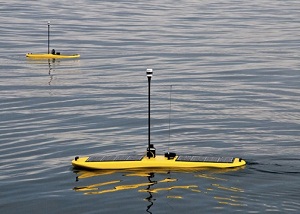Solar-powered Wave Gliders studying the Pacific for more than 300 days
 The yellow surfboard-looking apparatus covered with solar panels floating by your cruise ship to Hawaii is actually one of four unmanned Wave Gliders developed by Liquid Robotics that’s scouring the Pacific Ocean as part of the PacX Challenge. By the time the Wave Gliders have completed their 33,000 nautical mile, cumulative journey, they will have collected and transmitted nearly 2.3 million data points wirelessly thanks to their solar arrays.
The yellow surfboard-looking apparatus covered with solar panels floating by your cruise ship to Hawaii is actually one of four unmanned Wave Gliders developed by Liquid Robotics that’s scouring the Pacific Ocean as part of the PacX Challenge. By the time the Wave Gliders have completed their 33,000 nautical mile, cumulative journey, they will have collected and transmitted nearly 2.3 million data points wirelessly thanks to their solar arrays.
“The Wave Gliders have two energy sources: one is the wave for propulsion; the other is solar power. We can use all the solar power to run sensors and communications,” said Liquid Robotics spokesperson Joanne Masters. “Their propulsion is totally by the energy of the wave, no fuel, no batteries. That’s really the innovation and technology. There’s a lot behind it.”
During their epic journey they will be beaming back publicly available data allowing researchers and scientists access to information about the Pacific that’s being collected in near real-time, in a manner that’s never been attempted before.
“They’re going to be checking for weather, currents, water salinity and all of that,” Masters said. “No one’s had this type of data available for free. There’s so much of the ocean we don't know about, and this will give us additional insights.”
The robots offer a significant cost advantage over mounting a boat research effort.
“It changes the cost of data gathering,” Masters said.
There are no fuel costs for the Wave Gliders. And while the robots aren’t designed to be disposable, if one’s propulsion system fails, it’s not likely that Liquid Robotics would mount a rescue effort.
“It’s not like you have a $20 million ship that sinks,” she said.
Once the Wave Gliders reach Hawaii, they will split off into two teams. Two will head to Japan and the Mariana Trench. The other two will head to Australia. The trip to the Mariana Trench will compliment Virgin Oceanic’s dive research at the absolute bottom of the ocean in the trench, according to Masters.
Virgin Oceanic and Ocean Google Earth are the main sponsors of the Wave Glider research, although the majority of project funding is coming from Liquid Robotics.
While their route already is set, Liquid Robotics could alter the robots’ courses if necessary to avoid a significant event like a hurricane.
“The beauty of these is they're remotely piloted. We can certainly adjust it,” Masters said.
And if something scientifically significant happened while the Wave Gliders were in the region, they could be programmed to go to the event.
If successful, they will earn a Guinness World Record for longest trip completed by an unmanned ocean vessel.
Image courtesy of Liquid Robotics.



